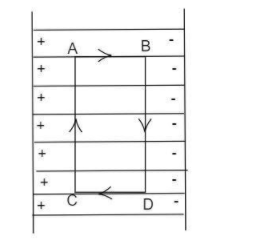
A uniform electric field $E$ exists between two charged plates. What would be the work done in moving a charge $q$ along the closed $ABCDA$ ?

(A) $\oint {E.dl} $
(B) $ - \oint {E.dl} $
(C) Zero
(D) None of these

Answer
554.4k+ views
Hint:Consider the charge at any point and it is moved along the closed rectangle $ABCDA$ . Find the work done to move a charge from that point to reach the point again in a closed loop by using the formula of the work done given below.
Useful formula:
The formula for the work done to move the charge along the electric field is given by
$w = \int {\vec E.d\vec l} $
Where $w$ is the work done, $\vec E$ is the electric field along with its direction and $dl$ is the change in the length.
Complete step by step solution:
The electric field lines in the given diagram, shows that it moves from the positive charge and reaches the negative charge. Let us consider that the charge $q$ is placed at the point $A$ , then the work is done to move the charge along the closed lines $ABCDA$ .
$w = \int {\vec E.d\vec l} $
Since $\vec E$ is constant,
$w = \vec E\int {d\vec l} $
Since the length remains the same, the change in the length tends to zero. Hence,
$w = \vec E\int {\vec 0} $
The integration of the zero is also zero, substituting that in the above equation, we get
$w = 0$
Hence the work done to bring the charge $q$ along the closed line $ABCDE$ is zero.
Thus the option (C) is correct.
Note:The work done in bringing the charge along the closed path is always zero. This is because the closed path has a uniform electric field in its entire area and the electrostatic forces in it is conservative forces and hence the value of the work done is zero.
Useful formula:
The formula for the work done to move the charge along the electric field is given by
$w = \int {\vec E.d\vec l} $
Where $w$ is the work done, $\vec E$ is the electric field along with its direction and $dl$ is the change in the length.
Complete step by step solution:
The electric field lines in the given diagram, shows that it moves from the positive charge and reaches the negative charge. Let us consider that the charge $q$ is placed at the point $A$ , then the work is done to move the charge along the closed lines $ABCDA$ .
$w = \int {\vec E.d\vec l} $
Since $\vec E$ is constant,
$w = \vec E\int {d\vec l} $
Since the length remains the same, the change in the length tends to zero. Hence,
$w = \vec E\int {\vec 0} $
The integration of the zero is also zero, substituting that in the above equation, we get
$w = 0$
Hence the work done to bring the charge $q$ along the closed line $ABCDE$ is zero.
Thus the option (C) is correct.
Note:The work done in bringing the charge along the closed path is always zero. This is because the closed path has a uniform electric field in its entire area and the electrostatic forces in it is conservative forces and hence the value of the work done is zero.
Recently Updated Pages
Master Class 12 Social Science: Engaging Questions & Answers for Success

Master Class 12 Physics: Engaging Questions & Answers for Success

Master Class 12 Maths: Engaging Questions & Answers for Success

Master Class 12 Economics: Engaging Questions & Answers for Success

Master Class 12 Chemistry: Engaging Questions & Answers for Success

Master Class 12 Business Studies: Engaging Questions & Answers for Success

Trending doubts
What are the major means of transport Explain each class 12 social science CBSE

Which are the Top 10 Largest Countries of the World?

Draw a labelled sketch of the human eye class 12 physics CBSE

How much time does it take to bleed after eating p class 12 biology CBSE

Explain sex determination in humans with line diag class 12 biology CBSE

Explain sex determination in humans with the help of class 12 biology CBSE




